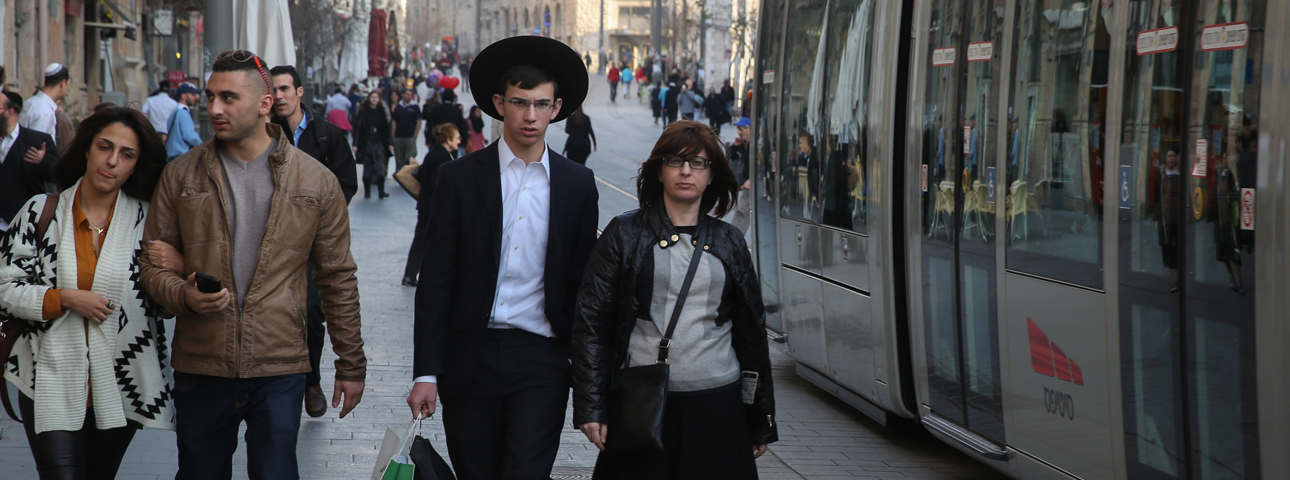Who are the ultra-Orthodox?
The ultra-Orthodox are Israel’s biggest sociological mystery. Their self-segregation, compounded by their compatriots’ lack of interest, has walled them up inside a black box that the Israeli majority cannot fathom.

Every eighth citizen of Israel is an ultra-Orthodox Jew. The fertility rate of ultra-Orthodox women—which is three times that of their secular counterparts in Israel—has produced a vast community of a million people, whose future still lies ahead of it: fully fifty percent of all ultra-Orthodox were born in the twenty-first century. Rabbi Aharon Yehuda Leib Shteinman of blessed memory, who passed away last month at the age of 104, was the leader of one of the youngest communities in the world.
Despite their numbers and importance, the ultra-Orthodox are Israel’s biggest sociological mystery. Their self-segregation, compounded by their compatriots’ lack of interest, has walled them up inside a black box that the Israeli majority cannot fathom. The attitude towards them is based on two dueling stereotypes:
On the one hand, their self-segregation and the political battles they wage, such as the conflict over prayers at the Western Wall, shape the public view that they are extremists, obscurantists, and exploiters. On the other hand, some see the ultra-Orthodox as the authentic Jews, without whom the Jewish people cannot survive. Ariel Sharon, secular through and through, often said that “if we don’t have Yeshivot there will be no Jewish people.”
Stereotypes—positive and negative—are an obstacle to the development of a serious and peaceful partnership between the ultra-Orthodox and the rest of Israel. So it is vital to make the facts about the ultra-Orthodox available—a mission served by The Yearbook on Ultra-Orthodox Society in Israel 2017, published this week by the Israel Democracy Institute and the Jerusalem Institute for Policy Research.
Unlike the situation in the past, today ultra-Orthodox are entering the workforce in droves. In 2002, only a third of Israeli ultra-Orthodox men and half of ultra-Orthodox women were employed. Today, the majority of ultra-Orthodox work—half of the men and two-thirds of the women. As a result, the sector’s economic distress has dropped sharply, from 58% below the poverty line in 2005 to 45% today. If the government acts wisely, by limiting economic support for yeshiva (seminary) students and increasing the incentives for ultra-Orthodox workers and their employers, the proportion of ultra-Orthodox who go out to work will continue to grow. This is an existential need for the Israeli economy.
The ultra-Orthodox are also flocking to higher education. Their enrollment in post-secondary institutions has grown tenfold in the past decade, to around 11,000 today. This includes 1,500 who are studying for advanced degrees. The High Court of Justice is currently hearing a petition alleging that gender and sector-based segregation on college campuses is unconstitutional. Its decision needs to strike a balance between the real concern about discrimination against women and the serious problem of excluding ultra-Orthodox from higher education. A purist position on either side would cost all of us dearly.
The ultra-Orthodox and the military (IDF) is another sad story. As of today, roughly a third of male graduates of ultra-Orthodox schools are enlisting in the IDF or National Service. Although this is insufficient and we still have a long road ahead of us, here too there is a clear trend towards integration. The Knesset, which needs to pass a new compulsory conscription law during the coming year, will have to show moderation and balance: ultra-Orthodox must not enjoy a blanket exemption from service, but neither should they be forced into the military by criminal sanctions. The appropriate way to encourage enlistment in the “people’s army” involves a variety of incentives that exert strong economic leverage.
Over the past seven years, internet use by ultra-Orthodox has increased from 28% to 43% of the sector. All the information in the world is now available to almost half of ultra-Orthodox. The internet is a channel that tunnels deep under the walls that cloister the ultra-Orthodox from the rest of the world. Silicon Valley has made inroads into the ultra-Orthodox city Bnei Brak, with huge effects.
The changes of the past fifteen years extend to demography: ultra-Orthodox are marrying later than in the past (the proportion of ultra-Orthodox who marry before age 24 has decreased from 61% to “only” 44%); the average number of children per woman has decreased by 0.6 (from 7.5 to 6.9); and the growth rate of the ultra-Orthodox education systems has slowed by a quarter within only four years.
All these numbers reflect significant changes, given the short time period, and clearly herald the start of a substantial “normalization” of ultra-Orthodox society in Israel. Will the process decelerate or accelerate? It is the ultra-Orthodox themselves who will make the decision. No one can or should decide for them. Nevertheless, a wise and balanced policy—in legislation, budgeting, and jurisprudence—is the need of the hour.
First published in the Forward
